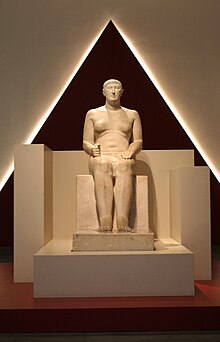
The vizier was the highest official in ancient Egypt to serve the pharaoh (king) during the Old, Middle, and New Kingdoms.[1] Vizier is the generally accepted rendering of ancient Egyptian tjati, tjaty etc., among Egyptologists.[2] The Instruction of Rekhmire (Installation of the Vizier), a New Kingdom text, defines many of the duties of the tjaty, and lays down codes of behavior. The viziers were often appointed by the pharaoh. During the 4th Dynasty and early 5th Dynasty, viziers were exclusively drawn from the royal family; from the period around the reign of Neferirkare Kakai onwards, they were chosen according to loyalty and talent or inherited the position from their fathers.[3]

| ||||
| Vizier (Tjaty) in hieroglyphs | ||||
|---|---|---|---|---|
| Era: New Kingdom (1550–1069 BC) | ||||
- ^ Shaw, Ian (2002). The Oxford History of Ancient Egypt. Oxford University Press. p. 104. ISBN 978-0-19-280293-4.
- ^ Gardiner, Alan Henderson (1957). Egyptian Grammar; Being an Introduction to the Study of Hieroglyphs (3rd ed.). Oxford: Griffith Institute, Ashmolean Museum. p. 43. ISBN 0 900416 351.
- ^ M. Heimlich, “Ancient Egyptian Literature”, vol.2, pp.21ff.[date missing]